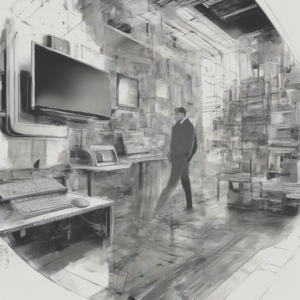Navigating the Shifting Sands: A Deep Dive into Evolving Retail Industry Trends
The retail industry is in constant flux, a dynamic landscape shaped by technological advancements, shifting consumer preferences, and global economic forces. Understanding these trends is crucial for businesses to not only survive but thrive in this competitive environment. This in-depth analysis explores key trends shaping the future of retail.
1. The Omni-Channel Experience: Seamless Integration Across Touchpoints
Consumers expect a seamless shopping experience, regardless of whether they’re browsing online, visiting a physical store, or using a mobile app. The days of siloed channels are over. Omni-channel retail focuses on integrating all touchpoints to provide a cohesive and personalized experience. This includes:
- Unified Inventory Management: Real-time visibility into inventory levels across all channels allows for accurate order fulfillment and avoids stockouts.
- Personalized Recommendations: Leveraging data from various channels to offer tailored product recommendations based on past purchases and browsing history.
- Click-and-Collect: Offering the convenience of online ordering with in-store pickup, streamlining the purchase process.
- In-Store Technology Integration: Utilizing technologies like mobile point-of-sale systems, interactive displays, and digital signage to enhance the in-store experience.
- Omnichannel Customer Service: Providing consistent and helpful customer support across all channels, regardless of how the customer initiates contact.
2. The Rise of E-commerce and its Evolution
E-commerce continues its rapid growth, driven by increased internet penetration and consumer preference for convenience. However, the landscape is evolving beyond simple online stores:
- Mobile Commerce (M-commerce): Shopping on mobile devices is rapidly overtaking desktop shopping, demanding optimized mobile websites and apps.
- Social Commerce: Integrating e-commerce directly into social media platforms, allowing users to shop without leaving their preferred social networks.
- Live Streaming Commerce: Brands are using live video streams to showcase products, interact with customers in real-time, and drive sales.
- Personalization and AI-Powered Recommendations: Utilizing artificial intelligence to personalize product recommendations and improve the customer experience.
- Subscription Models: Recurring subscription services are gaining popularity, providing a steady stream of revenue and fostering customer loyalty.
3. Data Analytics and the Power of Insights
Data is the new oil in the retail industry. Collecting and analyzing customer data is crucial for making informed decisions and optimizing business strategies:
- Customer Segmentation: Identifying different customer groups based on demographics, purchasing behavior, and preferences to tailor marketing efforts.
- Predictive Analytics: Using data to forecast future trends, optimize inventory management, and personalize customer interactions.
- Real-time Data Analysis: Monitoring key metrics in real-time to identify potential issues and make immediate adjustments.
- Loyalty Programs and Customer Relationship Management (CRM): Leveraging data to build strong customer relationships, foster loyalty, and increase customer lifetime value.
- Supply Chain Optimization: Utilizing data analytics to optimize supply chain processes, reduce costs, and improve efficiency.
4. The Experience Economy: Prioritizing Customer Engagement
Consumers are increasingly seeking experiences, not just products. Retailers are responding by creating engaging and memorable shopping experiences:
- Experiential Retail: Creating interactive and immersive shopping environments that engage all five senses.
- Personalized Service: Providing tailored customer service that goes beyond simple transactions.
- Community Building: Fostering a sense of community among customers through events, workshops, and social media engagement.
- Sustainability and Ethical Sourcing: Consumers are increasingly conscious of environmental and social issues, demanding transparency and ethical practices from retailers.
- Gamification: Incorporating game mechanics into the shopping experience to increase engagement and reward loyalty.
5. The Rise of Automation and Artificial Intelligence (AI)
Automation and AI are transforming various aspects of the retail industry, increasing efficiency and improving the customer experience:
- Robotics and Automation in Warehousing: Automating warehouse operations to improve efficiency and reduce costs.
- AI-Powered Chatbots: Providing instant customer support and answering frequently asked questions.
- AI-Driven Personalized Recommendations: Tailoring product recommendations based on individual customer preferences.
- Inventory Management and Forecasting: Utilizing AI to optimize inventory levels and predict future demand.
- Fraud Detection and Prevention: Employing AI to identify and prevent fraudulent transactions.
6. The Importance of Sustainability and Ethical Practices
Consumers are becoming increasingly conscious of the environmental and social impact of their purchases. Retailers that prioritize sustainability and ethical practices are gaining a competitive advantage:
- Sustainable Packaging: Reducing waste and using eco-friendly packaging materials.
- Ethical Sourcing: Ensuring that products are sourced responsibly and ethically.
- Carbon Footprint Reduction: Minimizing the environmental impact of operations.
- Circular Economy Models: Implementing strategies to reduce waste and promote reuse and recycling.
- Transparency and Traceability: Providing customers with clear information about the origin and production of products.
7. The Changing Retail Landscape: Adaptability and Innovation
The retail industry is characterized by its constant evolution. To thrive in this dynamic environment, retailers must embrace change and prioritize innovation:
- Agile Business Models: Adopting flexible and adaptable business models to respond quickly to changing market conditions.
- Continuous Improvement: Constantly seeking ways to improve processes, enhance the customer experience, and optimize operations.
- Investment in Technology: Investing in new technologies to improve efficiency, enhance customer engagement, and gain a competitive edge.
- Embracing New Business Models: Exploring new business models such as subscription services, marketplace models, and personalized experiences.
- Focus on Customer Needs: Prioritizing customer needs and expectations to build loyalty and drive sales.
8. The Influence of Geopolitical Factors and Economic Shifts
Global events and economic shifts significantly impact the retail industry. Understanding these factors is crucial for navigating uncertainty:
- Supply Chain Disruptions: Geopolitical instability and natural disasters can disrupt supply chains, impacting product availability and costs.
- Economic Fluctuations: Economic downturns can reduce consumer spending, requiring retailers to adapt their strategies.
- Inflation and Pricing Strategies: Rising inflation necessitates careful pricing strategies to maintain profitability while remaining competitive.
- Global Trade Policies: Changes in global trade policies can impact import and export costs, influencing pricing and product availability.
- Consumer Confidence: Retail sales are directly correlated with consumer confidence, necessitating careful monitoring of economic indicators.





